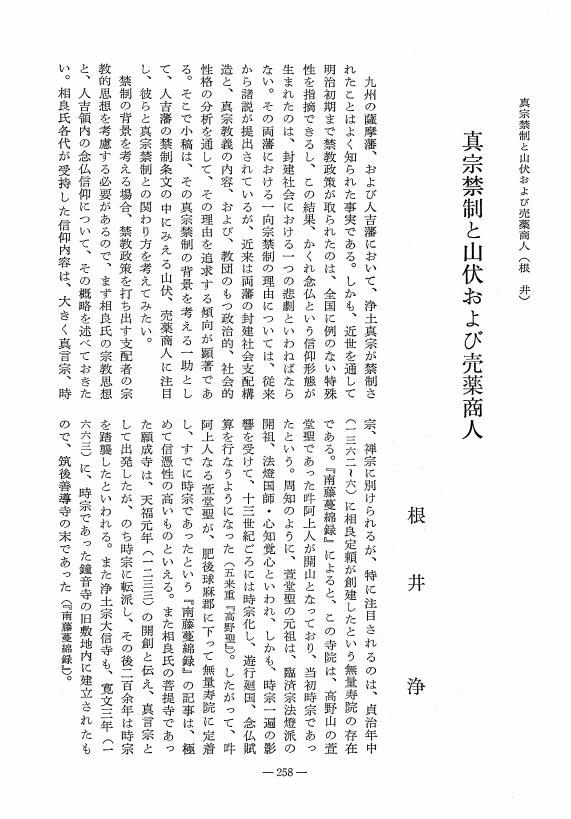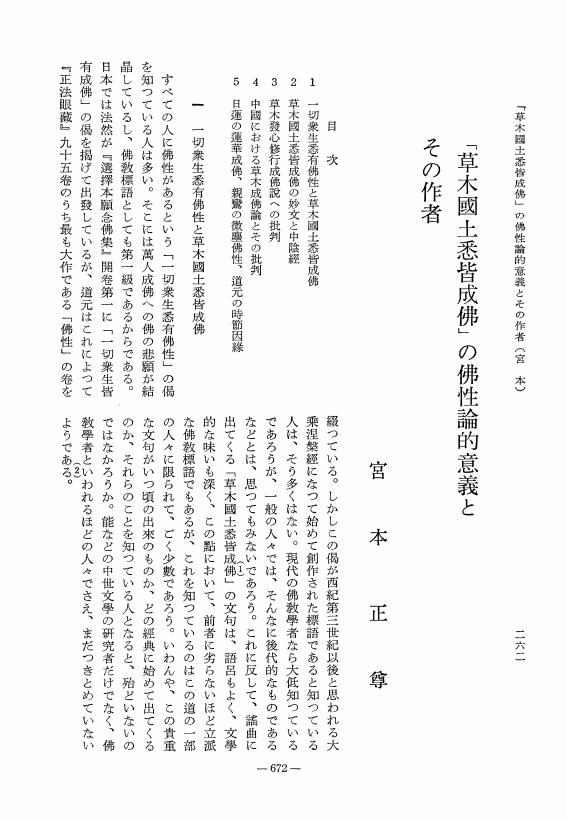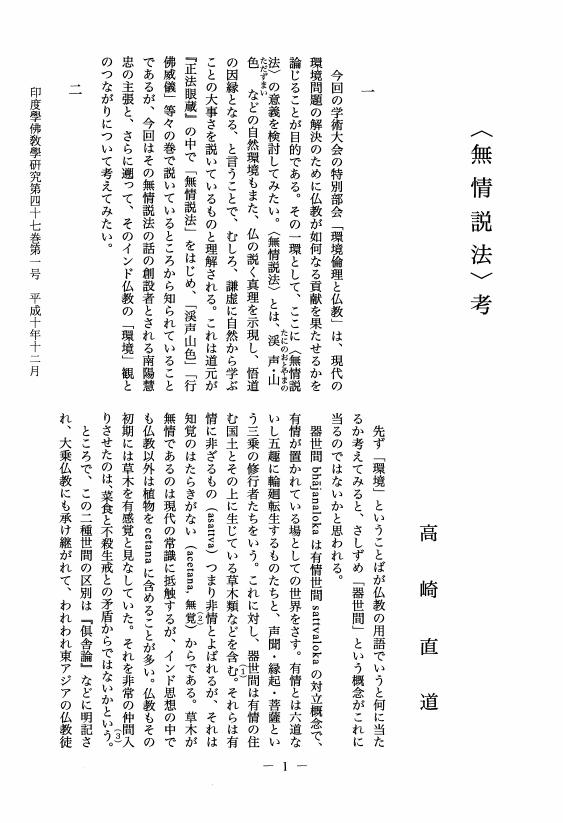4 0 0 0 五姓格別の源流を尋ねて
- 著者
- 佐久間 秀範
- 出版者
- 日本印度学仏教学会
- 雑誌
- 印度學佛教學研究 (ISSN:00194344)
- 巻号頁・発行日
- vol.55, no.3, pp.1112-1120, 2007
<b>ねらい (目的)</b>: 五姓格別というと唯識教学の旗印のように日本では考えられてきたが, 吉村誠氏, 橘川智昭氏などの研究から法相宗の事実上の創始者窺基に由来することが判った. 窺基はそれ以前の中国唯識思想が如来蔵思想に歪められていたことへの猛反発から玄奘がもたらした正統インド唯識思想を宣揚しようとし, 一乗思想の対局の五姓格別を持ち出したと考えられる. それならば五姓格別思想も, その起源をインドに辿れるはずである. これまでインドの文献資料の中にその起源を位置づける研究が見あたらなかったので, これを明らかにすることを目的としたのが当論文である.<br><b>方法 (資料):</b> 全体を導く指標として遁倫の『瑜伽論記』の記述を用い, 法相宗が五姓格別のインド起源の根拠と位置づける『瑜伽論』『仏地経論』『楞伽経』『大乗荘厳経論』(偈文, 世親釈, 無性釈, 安慧釈) と補足的資料として『勝鬘経』『般若経』に登場する当思想に関連するテキスト部分を逐一分析し, その歴史的道筋を辿った.<br><b>本論の成果等</b>: 諸文献のテキスト部分を分析した結果, 五姓格別思想は三乗思想と無因子の無種姓とが合成されたものであることが判った. その過程を辿れるのが『大乗荘厳経論』第三章種性品であり, 無種姓という項目が声聞, 独覚, 菩薩, 不定種性と並列された第五番目に位置づけられるようになったのは, 最終的には安慧釈になってからであることが歴史的な発展過程とともに明らかになった. その場合玄奘のもたらした瑜伽行派文献の中国語訳に基づく五姓格別思想は, 玄奘が主として学んだナーランダーの戒賢等の思想と云うよりも, ヴァラヴィーの安慧系の思想を受け継ぐものと考えられる. これは智と識の対応関係などにもいえることであるが, 法相宗の思想の基盤が従来考えられたようなナーランダーにあると云うよりも, ヴァラヴィーなど他の地域に依拠しているケースが認められたと云うことであり, これまでの常識とされていた中国法相教学の思想の位置づけを含めて, 教理の内容を吟味してゆくことを要求する内容となった.
- 著者
- 萩田 博
- 出版者
- Japanese Association of Indian and Buddhist Studies
- 雑誌
- 印度學佛教學研究 (ISSN:00194344)
- 巻号頁・発行日
- vol.46, no.1, pp.484-481, 1997-12-20 (Released:2010-03-09)
- 参考文献数
- 3
4 0 0 0 「憲法十七条」が想定している争乱
- 著者
- 石井 公成
- 出版者
- JAPANESE ASSOCIATION OF INDIAN AND BUDDHIST STUDIES
- 雑誌
- 印度學佛教學研究 (ISSN:00194344)
- 巻号頁・発行日
- vol.41, no.1, pp.133-139, 1992
4 0 0 0 OA 古ジャワにおける密教の受容 -ボロブドゥールと『初会金剛頂経』-
- 著者
- 石井 和子
- 出版者
- JAPANESE ASSOCIATION OF INDIAN AND BUDDHIST STUDIES
- 雑誌
- 印度學佛教學研究 (ISSN:00194344)
- 巻号頁・発行日
- vol.41, no.2, pp.1074-1070, 1993-03-25 (Released:2010-03-09)
4 0 0 0 OA 日本精神運動と仏教思想の諸相 -政治的ロマン主義への自発的同化・衛藤即応の場合-
- 著者
- 工藤 英勝
- 出版者
- JAPANESE ASSOCIATION OF INDIAN AND BUDDHIST STUDIES
- 雑誌
- 印度學佛教學研究 (ISSN:00194344)
- 巻号頁・発行日
- vol.49, no.1, pp.21-24, 2000-12-20 (Released:2010-03-09)
4 0 0 0 OA 近代仏教音楽の明治・大正
- 著者
- 山口 淳有
- 出版者
- JAPANESE ASSOCIATION OF INDIAN AND BUDDHIST STUDIES
- 雑誌
- 印度學佛教學研究 (ISSN:00194344)
- 巻号頁・発行日
- vol.49, no.2, pp.582-584, 2001-03-20 (Released:2010-03-09)
4 0 0 0 OA 新資料『仏説八関斎戒秘密求生浄土心要』について
- 著者
- 木村 清孝
- 出版者
- JAPANESE ASSOCIATION OF INDIAN AND BUDDHIST STUDIES
- 雑誌
- 印度學佛教學研究 (ISSN:00194344)
- 巻号頁・発行日
- vol.35, no.1, pp.126-131, 1986-12-25 (Released:2010-03-09)
4 0 0 0 OA 佛教的主體性について
- 著者
- 長尾 雅人
- 出版者
- JAPANESE ASSOCIATION OF INDIAN AND BUDDHIST STUDIES
- 雑誌
- 印度學佛教學研究 (ISSN:00194344)
- 巻号頁・発行日
- vol.1, no.1, pp.49-54, 1952-07-20 (Released:2010-03-09)
3 0 0 0 OA Asvín-と Násatya-
- 著者
- 後藤 敏文
- 出版者
- Japanese Association of Indian and Buddhist Studies
- 雑誌
- 印度學佛教學研究 (ISSN:00194344)
- 巻号頁・発行日
- vol.39, no.2, pp.982-977, 1991-03-20 (Released:2010-03-09)
3 0 0 0 OA いわゆる「無表業の誤解」について
- 著者
- 青原 令知
- 出版者
- 日本印度学仏教学会
- 雑誌
- 印度學佛教學研究 (ISSN:00194344)
- 巻号頁・発行日
- vol.65, no.2, pp.848-841, 2017-03-20 (Released:2018-01-16)
- 参考文献数
- 42
Nearly 90 years ago, Katō Seishin 加藤精神, the Buddhist scholar, pointed out that many Japanese scholars had some misunderstandings about avijñapti or non-expression, one of the distinguishing doctrines of the Sarvāstivāda. The opinion he claimed as a misunderstanding is that “the avijñapti plays a karmic role as a medium force between cause and its future result,” while he suggested the correct interpretation to be “a continuous function to restrain good and evil karma, abandoned in death at the latest.” This suggestion caused some controversies at the time, but afterward many Japanese researchers re-examined and approved his view as correct in its conclusion.In this paper, we elucidate the reason why those misunderstandings took place, considering the background of research in Japan. In Japanese traditional studies of the Abhidharmakośa, scholars handed down an explanation about avijñapti equal to Katō’s interpretation, and we cannot find any misunderstandings in the descriptions conforming to the tradition in those days. We find the misunderstandings mainly in many untraditional representations from the standpoint of the theory of the bīja or the function of seeds, identifying the avijñapti with the bīja of the Vijñānavāda or Sautrāntika. However, in the Abhidharmakośa, Vasubandhu actually rejects the avijñapti adopting the bīja theory, but he does not deal with the avijñapti as a substitute for the bīja, which is obviously confirmed from the context.Many Buddhist scholars in Japan used to make light of the Sarvāstivāda doctrine labelling Hīnayāna from the stance of Mahāyāna Buddhism. Such prejudiced approaches prevented them from a rational critique of the Abhidharma texts.
3 0 0 0 OA 『論事』の正典化―上座部大寺派における「声聞所説」と「仏所説」―
- 著者
- 林 隆嗣
- 出版者
- 日本印度学仏教学会
- 雑誌
- 印度學佛教學研究 (ISSN:00194344)
- 巻号頁・発行日
- vol.67, no.1, pp.445-438, 2018-12-20 (Released:2019-09-07)
- 参考文献数
- 10
In his article, “The Doctorinal Canonization of the Kathāvatthu” (IBK, Vol.63, No.3, 2015, pp.1243–1249), Toshifumi Shimizu investigated a discussion about the Kathāvatthu in the Aṭṭhasālinī, and concluded that, in order to accept what was spoken by the Buddha’s disciples (sāvakabhāsita) as “the word of the Buddha,” Theravādins required three conditions: (1) being based on māṭikā demonstrated by the Buddha, (2) corresponding to sabbaññutañāṇa, and (3) being retroactively approved with anumodanā given by the Buddha. However, his argument is not reasonable. The Aṭṭhasālinī explicitly mentions the reason why the Kathāvatthu composed by Moggaliputtatissa is buddhabhāsita as that, after the prediction of the Buddha, Moggaliputtatissa, following the summary (māṭikā) established by the Buddha, expounded it with the method given by the Buddha. The commentator compares it with the Madhupiṇḍikasutta of the Majjhimanikāya. In this sutta, the Buddha gives his disciples a brief discourse, and later Mahākaccāna expounds it to them in detail. That is finally confirmed by the Buddha saying, “I would have explained it in the same way that Mahākaccāna did. Such is exactly the meaning of this. Receive it as it is.”It is noteworthy that the Pāli commentator did not intend to establish a general principle to regard sāvakabhāsita as buddhabhāsita, and also the Pāli commentator, in spite of his exertion to regard the Kathāvatthu as buddhabhāsita, agrees that what the Pāli tipiṭaka called “Buddhavacana” (the word of the Buddha) consists not only of buddhabhāsita, but also of sāvakabhāsita, and so on. Thus acknowledging a text to be buddhabhāsita is not equivalent to its canonization. Relating to the canonization of the Kathāvatthu, we may rather note that Moggaliputtatissa was pre-approved with the Buddha’s prediction and was entrusted as a successor by the arahats at the second council to purge the saṅgha by holding the third council with this work.
3 0 0 0 OA 出征するジャイナ教在家信者
- 著者
- 河崎 豊
- 出版者
- Japanese Association of Indian and Buddhist Studies
- 雑誌
- 印度學佛教學研究 (ISSN:00194344)
- 巻号頁・発行日
- vol.53, no.1, pp.436-432, 2004-12-20 (Released:2010-03-09)
- 被引用文献数
- 1 1
3 0 0 0 OA 如来蔵思想は仏教にあらず
- 著者
- 松本 史朗
- 出版者
- Japanese Association of Indian and Buddhist Studies
- 雑誌
- 印度學佛教學研究 (ISSN:00194344)
- 巻号頁・発行日
- vol.35, no.1, pp.375-370, 1986-12-25 (Released:2010-03-09)
3 0 0 0 OA 複合語abhūtaparikalpaはkarmadhārayaか
- 著者
- 金 俊佑
- 出版者
- 日本印度学仏教学会
- 雑誌
- 印度學佛教學研究 (ISSN:00194344)
- 巻号頁・発行日
- vol.65, no.1, pp.364-361, 2016-12-20 (Released:2017-10-17)
- 参考文献数
- 8
Generally, the compound abhūtaparikalpa is understood to be a karmadhāraya. This paper argues that abhūtaparikalpa is not a karmadhāraya but instead a tatpuruṣa. Vasubandhu paraphrases abhūtaparikalpa as grāhyagrāhakavikalpa in the Madhyāntavibhāgabhāṣya. This means that abhūta corresponds to grāhyagrāhaka, and parikalpa corresponds to vikalpa. This grāhyagrāhakavikalpa is annotated as a tatpuruṣa by Kuiji 窺基. The same interpretation of this compound appeared in the translation of Paramārtha. Sthiramati also annotates abhūtaparikalpa as a tatpuruṣa. He regards abhūta as an adjective which modifies dvaya, not parikalpa. Therefore, the compound abhūtaparikalpa should be understood to be a tatpuruṣa.
3 0 0 0 OA 原始仏教における涅槃-nibbana と parinibbana-
- 著者
- 藤田 宏達
- 出版者
- Japanese Association of Indian and Buddhist Studies
- 雑誌
- 印度學佛教學研究 (ISSN:00194344)
- 巻号頁・発行日
- vol.37, no.1, pp.1-12, 1988-12-15 (Released:2010-03-09)
- 被引用文献数
- 2 1
3 0 0 0 関東における天台談義所の一側面
- 著者
- 山口 興順
- 出版者
- 日本印度学仏教学会
- 雑誌
- 印度學佛教學研究 (ISSN:00194344)
- 巻号頁・発行日
- vol.49, no.2, pp.595-597, 2001
3 0 0 0 OA 日蓮の真言宗批判について
- 著者
- 小林 正博
- 出版者
- Japanese Association of Indian and Buddhist Studies
- 雑誌
- 印度學佛教學研究 (ISSN:00194344)
- 巻号頁・発行日
- vol.35, no.1, pp.223-225, 1986-12-25 (Released:2010-03-09)
3 0 0 0 OA 真宗禁制と山伏および売薬商人
- 著者
- 根井 浄
- 出版者
- Japanese Association of Indian and Buddhist Studies
- 雑誌
- 印度學佛教學研究 (ISSN:00194344)
- 巻号頁・発行日
- vol.30, no.1, pp.258-261, 1981-12-31 (Released:2010-03-09)
3 0 0 0 OA 「草木國土悉皆成佛」の佛性論的意義とその作者
- 著者
- 宮本 正尊
- 出版者
- Japanese Association of Indian and Buddhist Studies
- 雑誌
- 印度學佛教學研究 (ISSN:00194344)
- 巻号頁・発行日
- vol.9, no.2, pp.672-701, 1961-03-31 (Released:2010-03-09)
3 0 0 0 OA 〈無情説法〉考
- 著者
- 高崎 直道
- 出版者
- Japanese Association of Indian and Buddhist Studies
- 雑誌
- 印度學佛教學研究 (ISSN:00194344)
- 巻号頁・発行日
- vol.47, no.1, pp.1-11, 1998-12-20 (Released:2010-03-09)
- 被引用文献数
- 2













